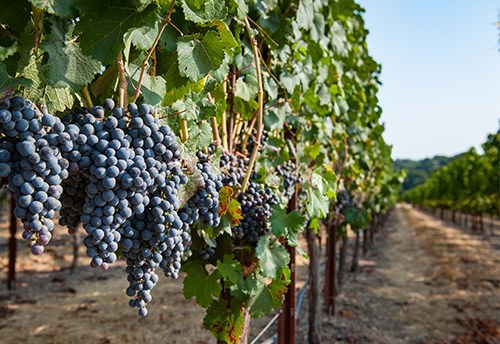Believe it or not, Cabernet Franc is one of the most popular grape varietals in the world. It’s true that it is primarily grown for blending with Cabernet Sauvignon and Merlot, but can also be crafted and bottled on its own. Its single varietal wines are highly regarded, and the grape is also
utilized in the production of rosé wines. While Cabernet Franc may seem like it has a secondary role in the blending of Bordeaux-style wines, it actually has an incredibly meaningful role in the history of grape varietals. Through DNA analysis, it has been shown that Cabernet Franc
is one of the two parents of Cabernet Sauvignon, Merlot and Carménère.
Cabernet Franc is believed to have been established in the Libournais region of southwest France during the 17th century, when Cardinal Richelieu transported cuttings of the vine to the Loire Valley and they were planted at the Abbey of Bourgueil. By the 18th century, plantings of Cabernet Franc were found throughout Fronsac, Pomerol and St-Emilion. As Cabernet Sauvignon became more popular in the 18th and 19th centuries, the similarity of the two grapes was noted and in 1997, DNA evidence emerged to show that Cabernet Franc had crossed with Sauvignon Blanc to produce Cabernet Sauvignon. As a vine and a wine, Cabernet Franc is more precocious than its offspring. Generally, Cabernet Franc buds and ripens at least one week before Cabernet Sauvignon, which allows the vine to thrive in slightly cooler climates than Cabernet Sauvignon, such as the Loire Valley in France or here in Dry Creek Valley. The vine is vigorous and upright with small to medium, elongated bunches. The berries are small and blue-black in color, with fairly thin skins.
Cabernet Franc is also lighter bodied than Cabernet Sauvignon, contributing finesse and a peppery perfume to blend with more robust varietals. It tends to be lighter in color saturation, well-structured and highly aromatic. Depending on the region and style of wine, additional aromas can include tobacco, graphite, raspberry, green olive, cassis and violets.
Due to the naturally high acidity and softer tannins, Cabernet Franc is an ideal wine for pairing with a wide variety of foods ranging from poultry and game to richer beef dishes and tomato-based sauces. For the ultimate experience, enjoy a glass with your favorite herb-crusted protein or vegetables with herb sauce. Try it yourself and let us know what you think!


